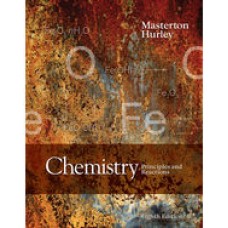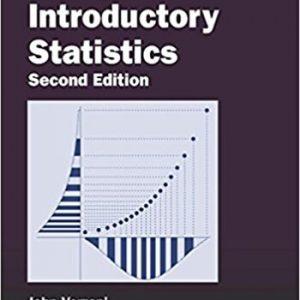Solution Manual for Chemistry Principles and Reactions, 8th Edition

Product details:
- ISBN-10 : 130507937X
- ISBN-13 : 978-1305079373
- Author: William L. Masterton
Discover all of the fundamental topics of general chemistry with this brief, reader-oriented book. CHEMISTRY: PRINCIPLES AND REACTIONS, 8e, provides a clear, concise presentation based on the authors’ more than 50 years of combined teaching experience. The book includes graded and concept-driven examples as well as examples that focus on molecular reasoning and understanding, as well as “Chemistry: Beyond the Classroom” essays that demonstrate the relevance of the concepts and highlight some of the most up-to-date uses of chemistry. A strong, enhanced art program helps readers visualize chemical concepts. Integrated end-of-chapter questions and Key Concepts correlate to OWLv2, the #1 online homework and tutorial system for chemistry.
Table contents:
- Ch 1: Matter and Measurements
- 1-1 Matter and Its Classifications
- 1-2 Measurements
- 1-3 Properties of Substances
- Summary Problem
- Questions and Problems
- Ch 2: Atoms, Molecules, and Ions
- 2-1 Atoms and the Atomic Theory
- 2-2 Components of the Atom
- 2-3 Quantitative Properties of the Atom
- 2-4 Introduction to the Periodic Table
- 2-5 Molecules and Ions
- 2-6 Formulas of Ionic Compounds
- 2-7 Names of Compounds
- Summary Problem
- Questions and Problems
- Ch 3: Mass Relations in Chemistry; Stoichiometry
- 3-1 The Mole
- 3-2 Mass Relations in Chemical Formulas
- 3-3 Mass Relations in Reactions
- Summary Problem
- Questions and Problems
- Ch 4: Reactions in Aqueous Solution
- 4-1 Precipitation Reactions
- 4-2 Acid-Base Reactions
- 4-3 Oxidation-Reduction Reactions
- Summary Problem
- Questions and Problems
- Ch 5: Gases
- 5-1 Measurements on Gases
- 5-2 The Ideal Gas Law
- 5-3 Gas Law Calculations
- 5-4 Stoichiometry of Gaseous Reactions
- 5-5 Gas Mixtures: Partial Pressures and Mole Fractions
- 5-6 Kinetic Theory of Gases
- 5-7 Real Gases
- Summary Problem
- Questions and Problems
- Ch 6: Electronic Structure and the Periodic Table
- 6-1 Light, Photon Energies, and Atomic Spectra
- 6-2 The Hydrogen Atom
- 6-3 Quantum Numbers
- 6-4 Atomic Orbitals; Shapes and Sizes
- 6-5 Electron Configurations in Atoms
- 6-6 Orbital Diagrams of Atoms
- 6-7 Electron Arrangements in Monatomic Ions
- 6-8 Periodic Trends in the Properties of Atoms
- Summary Problem
- Questions and Problems
- Ch 7: Covalent Bonding
- 7-1 Lewis Structures; the Octet Rule
- 7-2 Molecular Geometry
- 7-3 Polarity of Molecules
- 7-4 Atomic Orbitals; Hybridization
- Summary Problem
- Questions and Problems
- Ch 8: Thermochemistry
- 8-1 Principles of Heat Flow
- 8-2 Measurement of Heat Flow; Calorimetry
- 8-3 Enthalpy
- 8-4 Thermochemical Equations
- 8-5 Enthalpies of Formation
- 8-6 Bond Enthalpy
- 8-7 The First Law of Thermodynamics
- Summary Problem
- Questions and Problems
- Ch 9: Liquids and Solids
- 9-1 Comparing Solids, Liquids, and Gases
- 9-2 Liquid-Vapor Equilibrium
- 9-3 Phase Diagrams
- 9-4 Molecular Substances; Intermolecular Forces
- 9-5 Network Covalent, Ionic, and Metallic Solids
- 9-6 Crystal Structures
- Summary Problem
- Questions and Problems
- Ch 10: Solutions
- 10-1 Concentration Units
- 10-2 Principles of Solubility
- 10-3 Colligative Properties of Nonelectrolytes
- 10-4 Colligative Properties of Electrolytes
- Summary Problem
- Questions and Problems
- Ch 11: Rate of Reaction
- 11-1 Meaning of Reaction Rate
- 11-2 Reaction Rate and Concentration
- 11-3 Reactant Concentration and Time
- 11-4 Models for Reaction Rate
- 11-5 Reaction Rate and Temperature
- 11-6 Catalysis
- 11-7 Reaction Mechanisms
- Summary Problem
- Questions and Problems
- Ch 12: Gaseous Chemical Equilibrium
- 12-1 The N2O4-NO2 Equilibrium System
- 12-2 The Equilibrium Constant Expression
- 12-3 Determination of K
- 12-4 Applications of the Equilibrium Constant
- 12-5 Effect of Changes in Conditions on an Equilibrium System
- Summary Problem
- Questions and Problems
- Ch 13: Acids and Bases
- 13-1 Bronsted-Lowry Acid-Base Model
- 13-2 The Ion Product of Water
- 13-3 pH and pOH
- 13-4 Weak Acids and Their Equilibrium Constants
- 13-5 Weak Bases and Their Equilibrium Constants
- 13-6 Acid-Base Properties of Salt Solutions
- 13-7 Extending the Concept of Acids and Bases: The Lewis Model
- Summary Problem
- Questions and Problems
- Ch 14: Equilibria in Acid-Base Solutions
- 14-1 Buffers
- 14-2 Acid-Base Indicators
- 14-3 Acid-Base Titrations
- Summary Problem
- Questions and Problems
- Ch 15: Complex Ion and Precipitation Equilibria
- 15-1 Complex Ion Equilibria; Formation Constant (Kf)
- 15-2 Solubility; Solubility Product Constant (Ksp)
- 15-3 Precipitate Formation
- 15-4 Dissolving Precipitates
- Summary Problem
- Questions and Problems
- Ch 16: Spontaneity of Reaction
- 16-1 Spontaneous Processes
- 16-2 Entropy, S
- 16-3 Free Energy, G
- 16-4 Standard Free Energy Change, DeltaGDegree
- 16-5 Effect of Temperature, Pressure, and Concentration on Reaction Spontaneity
- 16-6 The Free Energy Change and the Equilibrium Constant
- 16-7 Additivity of Free Energy Changes; Coupled Reactions
- Summary Problem
- Questions and Problems
- Ch 17: Electrochemistry
- 17-1 Oxidation-Reduction Reactions Revisited
- 17-2 Voltaic Cells
- 17-3 Standard Voltages
- 17-4 Relations between EDegree, DeltaGDegree, and K
- 17-5 Effect of Concentration on Voltage
- 17-6 Electrolytic Cells
- 17-7 Commercial Cells
- Summary Problem
- Questions and Problems
- Ch 18: Nuclear Reactions
- 18-1 Nuclear Stability
- 18-2 Radioactivity
- 18-3 Rate of Radioactive Decay
- 18-4 Mass-Energy Relations
- 18-5 Nuclear Fission
- 18-6 Nuclear Fusion
- Summary Problem
- Questions and Problems
- Ch 19: Complex Ions
- 19-1 Composition of Complex Ions
- 19-2 Naming Complex Ions and Coordination Compounds
- 19-3 Geometry of Complex Ions
- 19-4 Electronic Structure of Complex Ions
- Summary Problem
- Questions and Problems
- Ch 20: Chemistry of the Metals
- 20-1 Metallurgy
- 20-2 Reactions of the Alkali and Alkaline Earth Metals
- 20-3 Redox Chemistry of the Transition Metals
- Summary Problem
- Questions and Problems
- Ch 21: Chemistry of the Nonmetals
- 21-1 The Elements and Their Preparation
- 21-2 Hydrogen Compounds of Nonmetals
- 21-3 Oxygen Compounds of Nonmetals
- 21-4 Oxoacids and Oxoanions
- Summary Problem
- Questions and Problems
- Ch 22: Organic Chemistry
- 22-1 Saturated Hydrocarbons: Alkanes
- 22-2 Unsaturated Hydrocarbons: Alkenes and Alkynes
- 22-3 Aromatic Hydrocarbons and Their Derivatives
- 22-4 Functional Groups
- 22-5 Isomerism in Organic Compounds
- 22-6 Organic Reactions
- Summary Problem
- Questions and Problems
- Ch 23: Organic Polymers, Natural and Synthetic
- 23-1 Synthetic Addition Polymers
- 23-2 Synthetic Condensation Polymers
- 23-3 Carbohydrates
- 23-4 Proteins
- Summary Problem
- Questions and Problems
- Appendices
- Appendix 1: Units, Constants, and Reference Data
- Appendix 2: Properties of the Elements
- Appendix 3: Exponents and Logarithms
- Appendix 4: Molecular Orbitals
- Appendix 5: Answers to Even-Numbered and Challenge Questions and Problems
- Index/Glossary
People also search:
|
chemistry principles and reactions 8th edition solutions pdf free |





